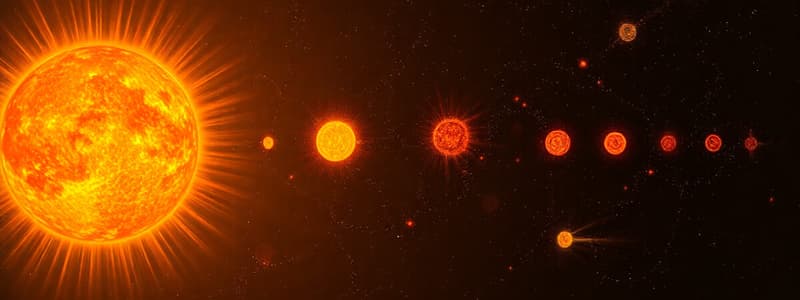Podcast
Questions and Answers
What is the Solar Cycle?
What is the Solar Cycle?
- The periodic change in solar activity over approximately 11 years (correct)
- The orbit of the Earth around the Sun
- A cycle of lunar phases
- A cycle of Earth's seasons
What are sunspots?
What are sunspots?
- Bright areas on the Sun's surface
- Planets that reflect sunlight
- Darker regions caused by magnetic activity (correct)
- Solar flares erupting from the Sun
During which phase of the Solar Cycle do sunspots typically increase in number?
During which phase of the Solar Cycle do sunspots typically increase in number?
- Solar minimum
- Solar eclipse
- Solar flare
- Solar maximum (correct)
How do sunspots affect solar energy output?
How do sunspots affect solar energy output?
What causes sunspots to form?
What causes sunspots to form?
What is a solar flare?
What is a solar flare?
What is the average duration of the Solar Cycle?
What is the average duration of the Solar Cycle?
How can sunspots impact Earth?
How can sunspots impact Earth?
What instrument is primarily used to observe sunspots?
What instrument is primarily used to observe sunspots?
Which of the following best describes the relationship between sunspot activity and solar radiation?
Which of the following best describes the relationship between sunspot activity and solar radiation?
Describe the Solar Cycle and explain its phases.
Describe the Solar Cycle and explain its phases.
Discuss the relationship between sunspots and solar flares.
Discuss the relationship between sunspots and solar flares.
Flashcards are hidden until you start studying
Study Notes
Solar Cycle and Sunspots
- The Solar Cycle is a periodic change in solar activity over approximately 11 years.
- Sunspots are darker regions on the Sun's surface caused by magnetic activity.
- Sunspots increase in number during the Solar Maximum phase of the cycle.
- Sunspots do not change solar energy output.
- Sunspots are caused by variations in the Sun's magnetic field.
- A solar flare is a large explosion on the Sun's surface.
- The average duration of the Solar Cycle is 11 years.
- Sunspots can disrupt satellite communications.
- Telescopes are primarily used to observe sunspots.
- More sunspots do not necessarily mean more solar radiation, they are both related to the Solar Cycle, but not directly correlated.
The Impact of the Solar Cycle on Earth
- Increased sunspot activity during the Solar Maximum phase can disrupt satellite communications and cause auroras (Northern Lights) on Earth.
- Solar flares and coronal mass ejections (CMEs) can impact Earth's atmosphere and technology, potentially causing power outages and disrupting radio communications.
- The Solar Cycle influences Earth's climate and space weather, with significant implications for technology and life on Earth.
Studying That Suits You
Use AI to generate personalized quizzes and flashcards to suit your learning preferences.




